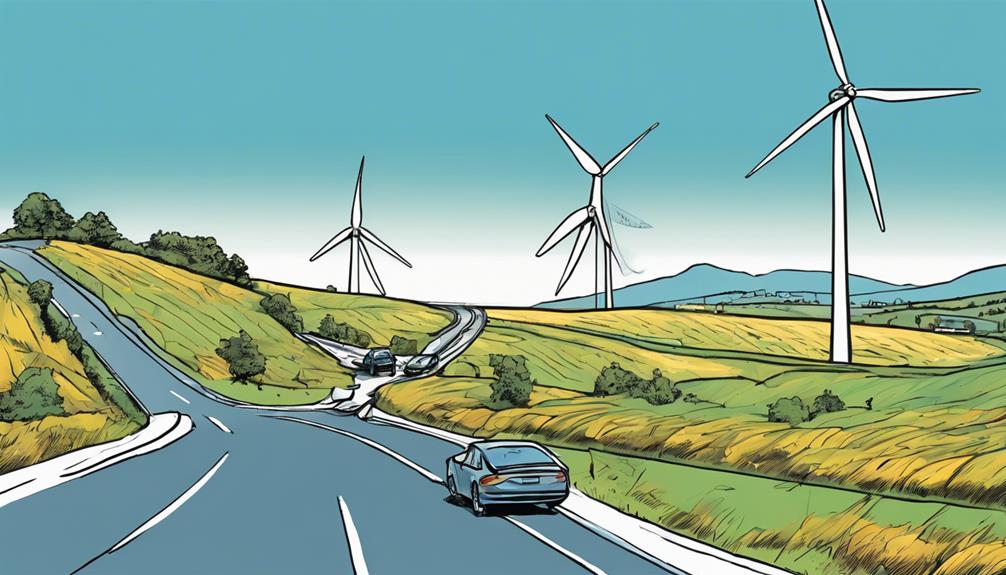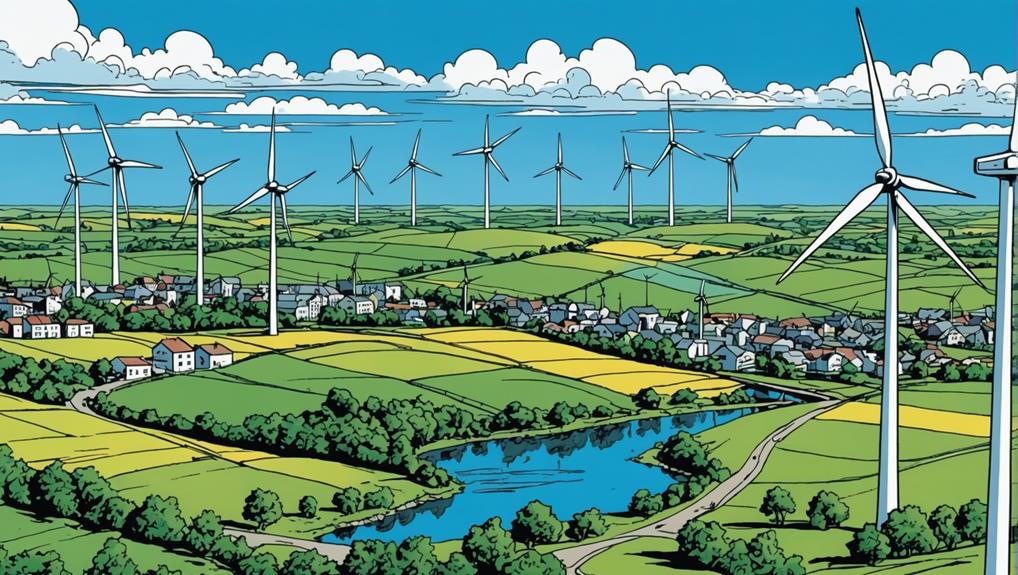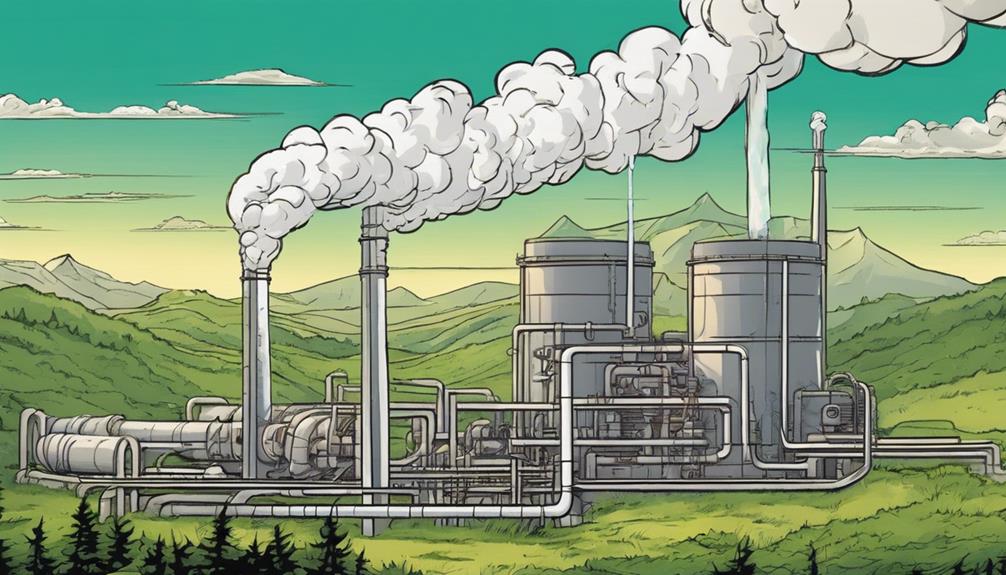Harness the wind turbine benefits on highways with cost-effective energy generation, job creation, and reduced energy costs. Empower rural and urban areas with electricity while sharing revenue. Mitigate wildlife interactions with strategic placement and design considerations, promoting environmental sustainability. Overcome technical challenges through optimized blade design and data-driven decisions. Explore innovative designs like portable turbines and modular sections for enhanced functionality. Drive efficiency by capturing wind energy for highway lights and urban infrastructures, promoting sustainable solutions and reducing carbon footprints. Despite challenges like land conflicts and maintenance costs, the potential for renewable energy along highways is vast.
Key Takeaways
- Cost-effective energy generation for highway infrastructure.
- Job creation in the renewable energy sector.
- Challenges like land use conflicts and maintenance.
- Benefits include revenue sharing and reduced energy costs.
- Environmental considerations for wildlife protection and sustainability.
Economic Impact of Highway Wind Turbines
Highway wind turbines offer notable economic benefits through cost-effective energy generation and job creation in the renewable energy sector. By harnessing wind power to generate electricity for highway lights, these turbines not only reduce energy costs but also cut down on carbon emissions.
The economic impact of highway wind turbines extends beyond just powering lights; they can also provide electricity for rural communities and urban infrastructure like traffic lights, enhancing local sustainability efforts.
Moreover, the implementation of wind turbines on highways presents a practical solution for utilizing wind energy in high-traffic areas. This not only promotes green infrastructure development but also creates potential revenue streams from excess power production.
Additionally, the job creation potential in the renewable energy sector through the installation and maintenance of these turbines can notably bolster local economies. Overall, highway wind turbines offer a promising avenue for sustainable energy generation and economic growth.
Environmental Considerations and Wildlife
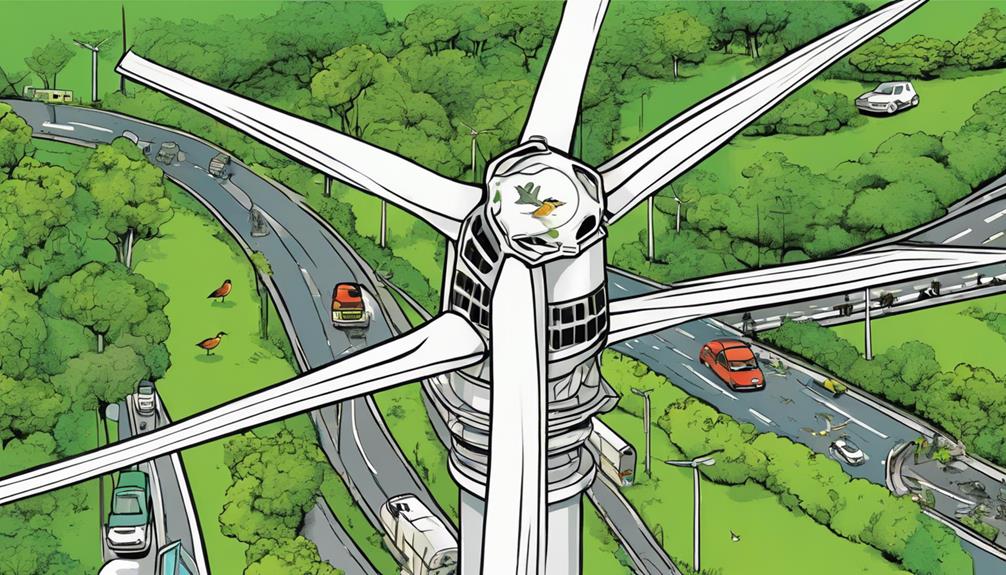
Mitigating potential impacts on wildlife and addressing environmental concerns are essential considerations when integrating wind turbines along highways. Wind projects near roadways have raised worries about their effects on local wildlife, prompting ongoing research to minimize interactions and reduce risks.
Strategies to lessen wildlife disturbances from highway wind turbines include proper placement, noise reduction measures, and wildlife-friendly design considerations. Advancements in technology and siting practices aim to diminish the environmental footprint of wind turbines placed alongside highways.
These turbines differ in their environmental impacts compared to traditional power plants, with concerns revolving around noise levels and visual aesthetics. The development of wildlife-friendly design features plays an important role in ensuring that wind projects near highways coexist harmoniously with local ecosystems.
Careful planning and continuous monitoring are necessary to uphold environmental sustainability and safeguard wildlife habitats in the vicinity of highway wind turbines.
Technical Challenges and Solutions
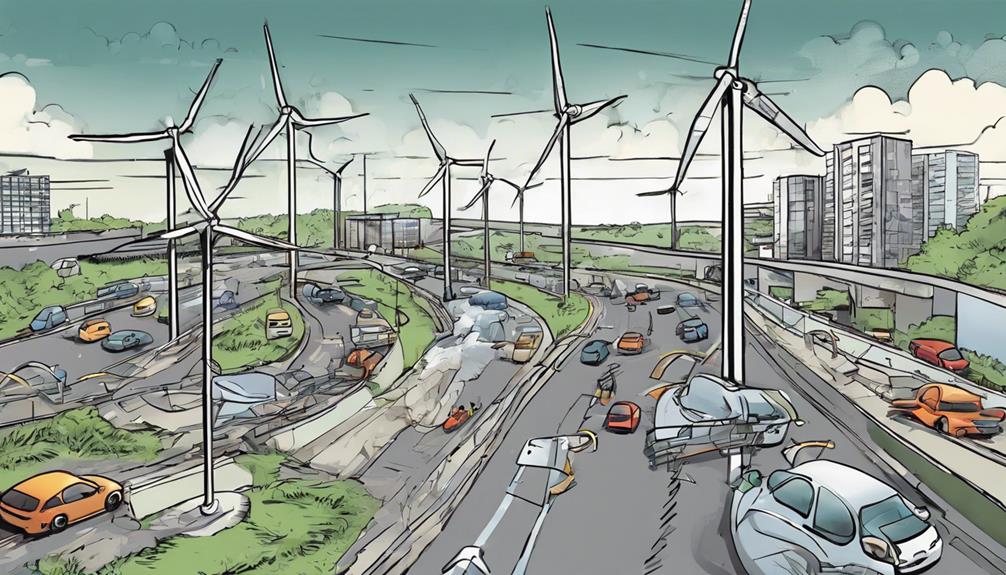
Efficiently capturing wind from passing vehicles to generate electricity poses technical challenges for wind turbines positioned along highways. One significant challenge lies in optimizing the design of turbine blades to effectively harness wind energy at varying speeds caused by vehicles passing at different velocities.
Additionally, the conversion of the direct current (DC) electricity generated by the turbines into alternating current (AC) for practical use requires the installation of inverters, adding complexity to the system.
Moreover, strategic placement of the turbines and careful consideration of their design are vital for maximizing energy production. Ensuring stability is another hurdle, as heavy components like batteries and generators need to be stored at the base of these turbines.
Detailed data collection on wind patterns and traffic flow is essential for making informed decisions regarding the placement and operation of highway wind turbines. Overcoming these technical challenges through innovative solutions will be key to the successful implementation of this sustainable energy source.
Innovative Design and Applications
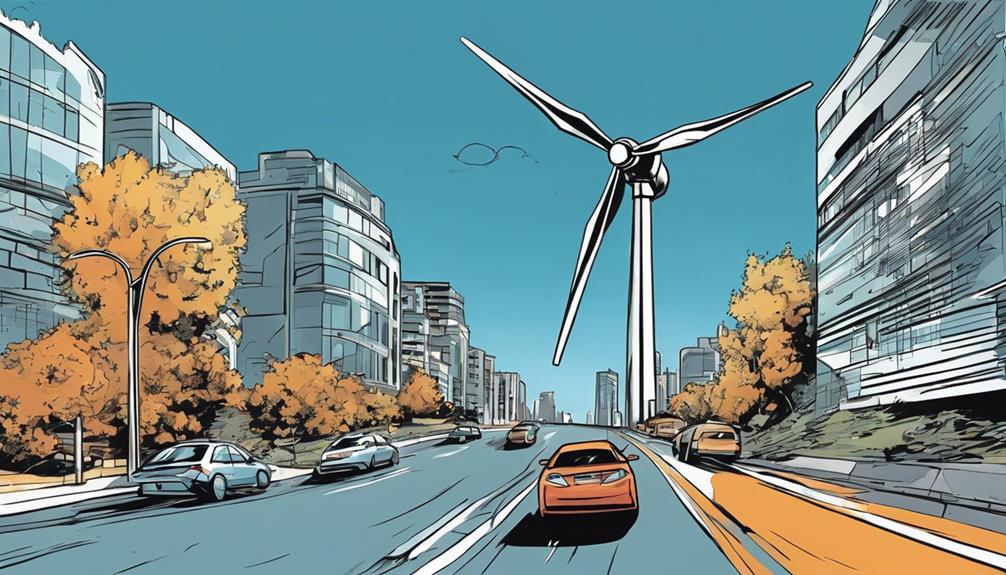
Incorporating innovative design concepts and applications is essential for maximizing the efficiency and impact of wind turbines along highways. One such design is Sanwal Muneer's portable carbon fiber wind turbine, which can power lamps and fans with sustainable energy, providing a practical solution for roadside energy needs. Additionally, innovative wind turbine designs for highways, such as gear turbines, modular sections, and turbines integrated into dividers, showcase the versatility and adaptability of these renewable energy sources.
To further illustrate the variety of innovative designs and applications for highway wind turbines, the table below highlights some key examples:
| Innovative Design | Application | Benefits |
|---|---|---|
| Center apparatus | Traffic wind turbines | Efficient energy generation and reduced pollution |
| Modular sections | Highway wind turbines | Scalability and ease of maintenance |
| Gear turbines | Urban infrastructure | Powering traffic lights and other amenities |
These innovative designs and applications not only enhance the functionality of wind turbines on highways but also contribute significantly to sustainability efforts and energy efficiency.
Practicality and Efficiency of Turbines
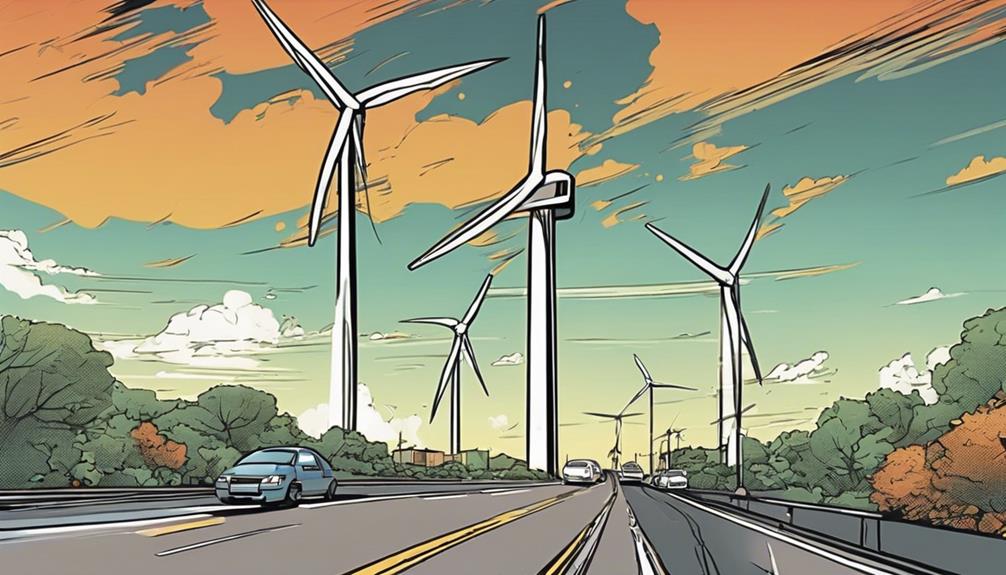
Wind turbines along highways efficiently capture wind energy from passing vehicles' draft force, demonstrating their practicality and efficiency in providing sustainable energy solutions for various infrastructures. Vertical axis wind turbines, specifically designed for roadside use, excel in harnessing wind from any direction, making them ideal for capturing the dynamic airflow near highways. These turbines have the potential to power highway lights during the night or supply electricity to urban infrastructures such as traffic lights, showcasing their versatility and applicability in enhancing energy efficiency.
Moreover, the practical applications of traffic wind turbines extend to generating electricity for rural communities and mitigating pollution from fossil fuels in cities. By utilizing artificial wind generated by passing vehicles, vertical axis wind turbines offer a promising avenue for sustainable energy solutions in diverse urban settings globally. Their efficient operation and ability to tap into readily available wind resources make them a viable option for reducing carbon footprints and promoting greener energy alternatives along highways.
Future Potential for Green Energy
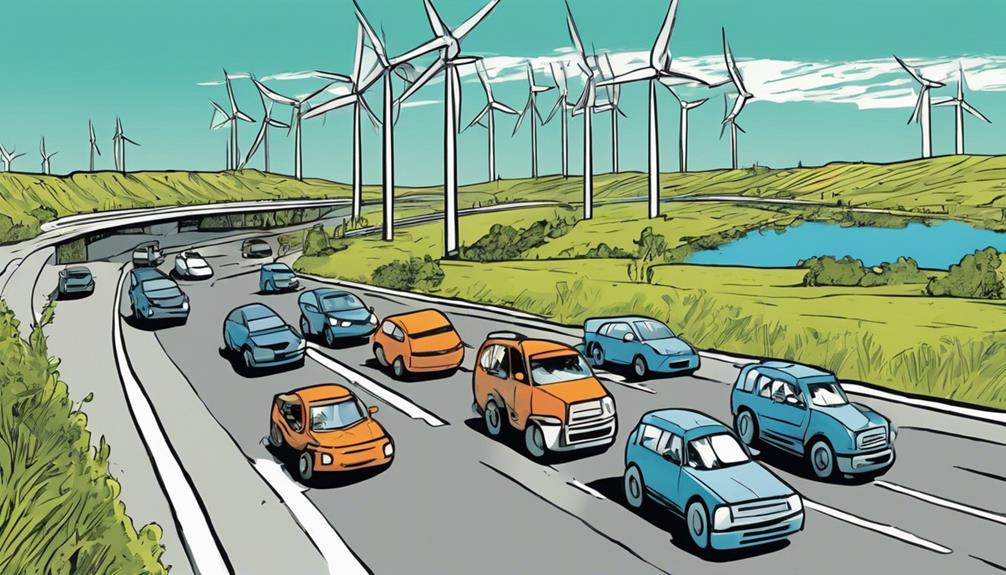
Harnessing the future potential for green energy entails exploring innovative ways to maximize renewable resources and advance sustainability efforts worldwide. Wind turbines along highways exemplify a step towards achieving this goal, offering environmentally friendly and economically viable energy solutions for sustainable development. Here are some key points to keep in mind:
- Grouping wind turbines along highways can generate substantial energy to support public services and infrastructure.
- Traffic wind turbines, powered by artificial wind, can be utilized not only along highways but also in various urban settings.
- The capacity of highway wind turbines to power diverse city infrastructures globally contributes significantly to green energy initiatives.
- Morningstar's GenStar MPPT, an integrated solar DC charging system, plays a vital role in enhancing the efficient power generation of highway wind turbines.
Community Benefits and Revenue Sharing
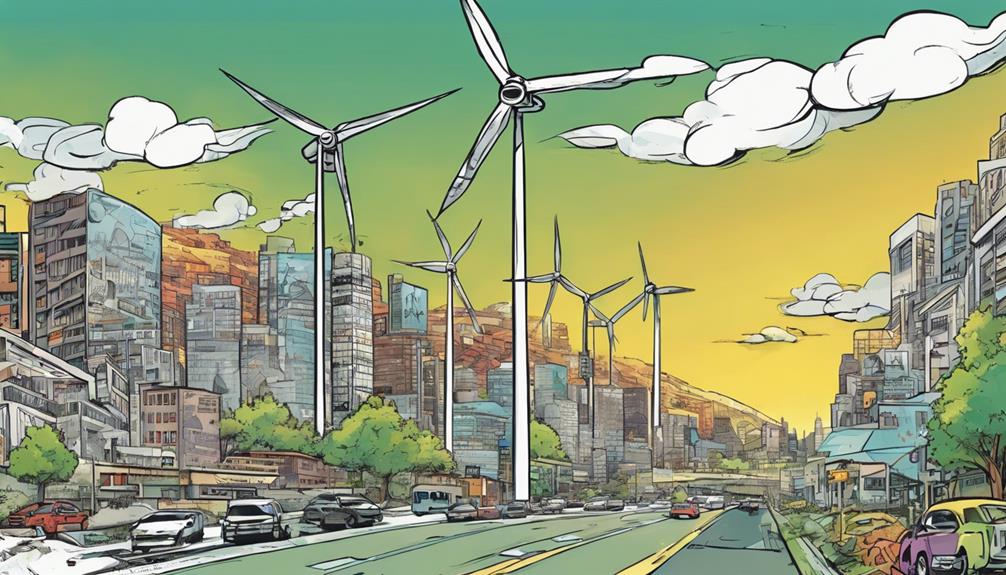
Communities can reap financial benefits and foster local development through revenue sharing from highway wind turbines. By entering into revenue-sharing agreements, communities can directly benefit from the electricity generated by these turbines. The revenue generated can then be allocated towards funding local projects, schools, and infrastructure improvements, enhancing the overall well-being of the community.
Furthermore, revenue sharing from highway wind turbines not only provides a sustainable source of income but also promotes renewable energy usage, contributing to a greener environment. This shared revenue can play an essential role in reducing local tax burdens, thereby easing the financial strain on residents.
Additionally, the financial injection from revenue sharing can stimulate economic growth within the community, creating job opportunities and fostering a more prosperous local economy. Overall, revenue sharing from highway wind turbines presents a valuable opportunity for communities to benefit financially while advancing towards a more sustainable and prosperous future.
Frequently Asked Questions
What Are 3 Disadvantages of Wind Turbines?
When considering wind turbines, remember that they can generate low-frequency noise, have a significant visual impact, and pose risks to wildlife. So, be cautious about these disadvantages when planning wind energy projects.
What Are the Positive and Negative Effects of Wind Turbines?
Positive effects of wind turbines include generating sustainable electricity and reducing carbon emissions. Negative effects may involve visual impact, noise, and potential wildlife interactions. Innovations work towards maximizing benefits and mitigating drawbacks for a balanced solution.
What Is the Biggest Problem With Wind Turbines?
The biggest problem with wind turbines is the intermittent nature of wind, affecting consistent energy generation. This challenge can hinder the reliability of wind power as a sustainable energy source, requiring innovative solutions for optimization.
What Challenges Do Wind Turbines Face?
Facing challenges, wind turbines must carefully consider limited ideal sites, noise and visual impacts on communities, costly grid connection upgrades, wildlife interactions, and safety standards near high-speed traffic. Planning is essential for successful implementation.
What Are the Benefits of Having a Wind Turbine on a Highway?
Having a wind turbine on a highway can provide numerous benefits. It can generate clean, renewable energy, help in reducing greenhouse gas emissions, and contribute to energy independence. Everything you need to know is that wind turbines on highways can utilize strong winds and contribute to a sustainable future.
Conclusion
To sum up, the integration of wind turbines on highways offers a promising solution for clean energy production. Despite challenges, the economic, environmental, and community benefits are clear.
As we look towards a greener future, the innovative design and practicality of these turbines provide hope for sustainable energy solutions. Embrace the wind of change and support the shift to renewable energy for a brighter tomorrow.
